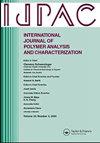RAFT聚合和接枝共聚物的合成及表征
IF 1.6
4区 工程技术
Q4 POLYMER SCIENCE
International Journal of Polymer Analysis and Characterization
Pub Date : 2025-05-13
DOI:10.1080/1023666X.2025.2502819
引用次数: 0
摘要
本研究通过在聚甲基丙烯酸甲酯骨架上引入聚乙二醇段,合成了一系列新型共聚物。为此,以1,2-二溴乙烷和乙基黄原酸钾为原料,合成了S,S ' -(乙烷-1,2-二基)O,O ' -二乙基双(碳酸二硫酸盐)RAFT试剂。以RAFT助剂、甲基丙烯酸甲酯和不同长度(PEG单元的分子量分别为200、400和1000 g.mol - 1)的聚乙二醇单甲醚单甲基丙烯酸甲酯(PEGMMA)为大单体,采用可逆加成-破碎链转移聚合(RAFT)法和接枝策略合成了聚(甲基丙烯酸甲酯-共聚(MMA-co-PEGMMA)共聚物。成功地得到了三种不同接枝度(5、10和20%质量比)的聚(MMA-co-PEGMMA)共聚物。采用FT-IR、1H-NMR、GPC、TGA和DSC等方法研究了聚(MMA-co-PEGMMA)共聚物的结构和热特性。本文章由计算机程序翻译,如有差异,请以英文原文为准。
Synthesis and characterization of a set of novel copolymers by using RAFT polymerization method and “grafting through” strategy
This study synthesized a series of novel copolymers by introducing the polyethylene glycol segments to the polymethyl methacrylate skeleton. For this purpose, S,S’-(ethane-1,2-diyl) O,O’-diethyl bis(carbonodithioate), named RAFT agent, was synthesized by reacting 1,2-dibromoethane with potassium ethyl xanthogenate. Poly(methyl methacrylate-co-polyethylene glycol monomethyl ether monomethacrylate) [poly(MMA-co-PEGMMA)] copolymer was synthesized by reversible addition-fragmentation chain transfer polymerization (RAFT) method and the “grafting through” strategy using the RAFT agent, methyl methacrylate, and different lengths (Mw of PEG unit = 200, 400, and 1000 g.mol−1) of polyethylene glycol monomethyl ether monomethacrylate (PEGMMA) as macromonomers. The three copolymers of poly(MMA-co-PEGMMA) with three different grafting degrees (5, 10, and 20% by mass) were obtained successfully. Structural and thermal features of poly(MMA-co-PEGMMA) copolymers were examined using FT-IR, 1H-NMR, GPC, TGA, and DSC methods.
求助全文
通过发布文献求助,成功后即可免费获取论文全文。
去求助
来源期刊
CiteScore
3.50
自引率
5.30%
发文量
37
审稿时长
1.6 months
期刊介绍:
The scope of the journal is to publish original contributions and reviews on studies, methodologies, instrumentation, and applications involving the analysis and characterization of polymers and polymeric-based materials, including synthetic polymers, blends, composites, fibers, coatings, supramolecular structures, polysaccharides, and biopolymers. The Journal will accept papers and review articles on the following topics and research areas involving fundamental and applied studies of polymer analysis and characterization:
Characterization and analysis of new and existing polymers and polymeric-based materials.
Design and evaluation of analytical instrumentation and physical testing equipment.
Determination of molecular weight, size, conformation, branching, cross-linking, chemical structure, and sequence distribution.
Using separation, spectroscopic, and scattering techniques.
Surface characterization of polymeric materials.
Measurement of solution and bulk properties and behavior of polymers.
Studies involving structure-property-processing relationships, and polymer aging.
Analysis of oligomeric materials.
Analysis of polymer additives and decomposition products.

 求助内容:
求助内容: 应助结果提醒方式:
应助结果提醒方式:


